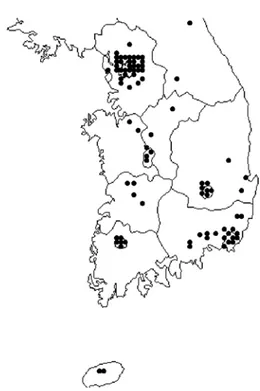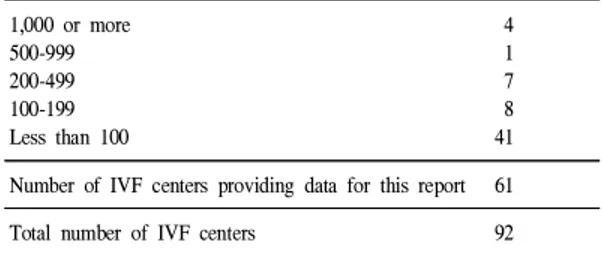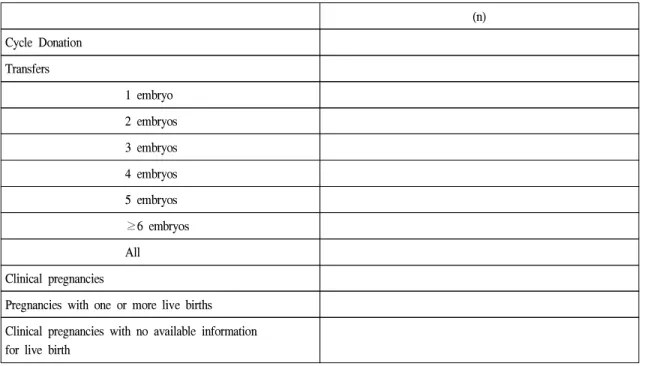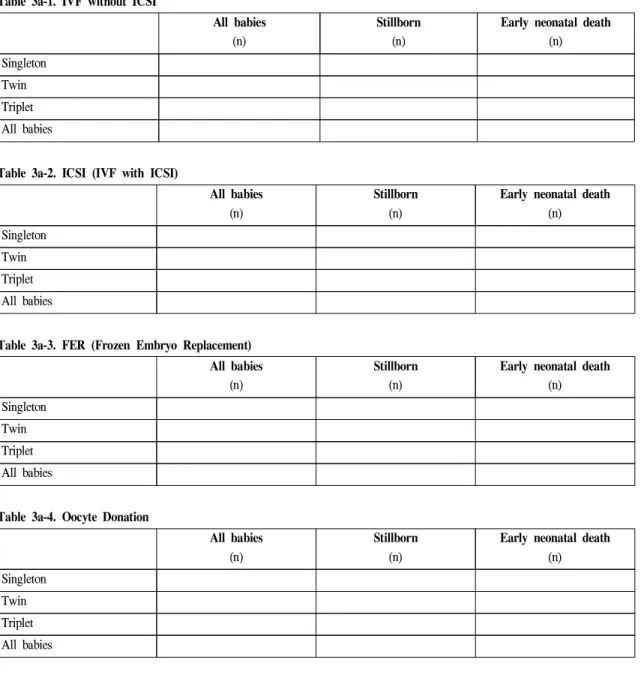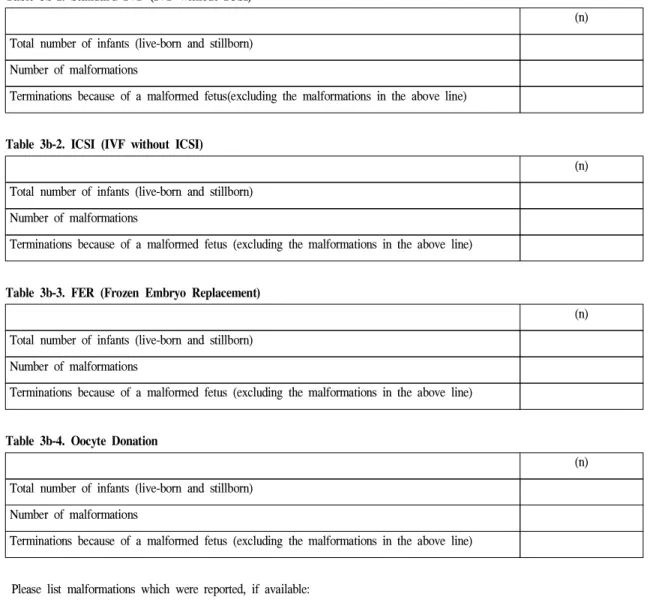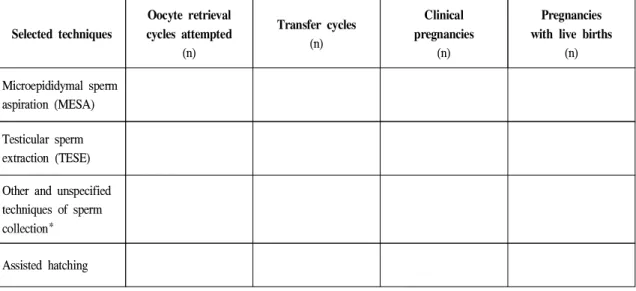1985년 국내에서 체외수정시술에 의한 첫 시험관아기 가 탄생한 이래 불임 환자 치료를 위한 보조생식술은 날 로 그 시술 기관과 시행수가 증가되고 있을 뿐만 아니 라, 치료성적도 괄목할 만큼 개선되는 등 불임증 진단과 치료에 많은 발전이 있어 왔다. 불임을 치료하기 위해 보조생식술을 시행하고 있는 의료기관으로부터의 자료 는 성공적인 보조생식술, 즉 생아의 출산을 가능하게 하 는 여러 가지 요소들에 대한 풍부하고 귀중한 자료가 될 수 있다. 각 의료기관별의 치료 성적은 그 자체로도 의 미가 있지만 성공률과 성공에 영향을 주는 요소에 대한 통합적인 분석을 위해서는 국내의 여러 의료기관으로부 터의 자료를 취합하여 국내 통계를 구해보는 것이 의미 가 있을 것이며, 이러한 조사는 국내 불임 환자 및 보조 생식술 시술 기관의 실태 파악에 도움을 주는 것은 물론 궁극적으로 국내 보조생식술에 관한 전체적이고 일관성 있는 자료를 장기적으로 처리 분석하여 불임증 치료의 방향까지 제시할 수 있을 것으로 기대된다.
1993년 5월 제정된 인공수태 윤리에 관한 선언에 의하 면, 인준된 인공수태시술 의료기관은 그 시술내용을 연 1회 이상 대한의사협회 (또는 동 협회가 지정한 관련학 회)에 보고하도록 되어 있으며, 1994년 본 학회 내에 인 공수태시술 의료기관 심사소위원회가 설치되었다. 대한 산부인과학회에서는 1992년부터 국내 보조생식술의 현 황을 조사하여 보고하여 오고 있고 2002년 7월 현재 92 개의 의료기관이 인공수태시술 의료기관으로 인준되어 있다 (Fig. 1). 이러한 조사사업의 일환으로 1999년도 보 조생식술 현황도 조사하여 이에 보고하게 되었다.
본 조사에 의해 얻어진 국내 보조생식술에 대한 자료 는 불임 환자 및 보조생식술 시술 기관의 실태파악에 도 움을 주는 것은 물론 더 나아가서는 시술방법의 계속적 인 개선과 발전, 부작용의 감소와 임신 성공률의 향상을
Fig. 1. Location of certified a ART clinics in Korea, 1999
도모하는데 유용한 자료로 활용될 것이다. 본 조사 연구 는 대한산부인과학회의 재정 지원하에 수행되었으며, 실 무에서 많은 노력을 기울인 대한산부인과학회의 직원 여러분들과 서울대학교병원의 천은경 선생, 정현정 선 생, 그리고 본 조사에 협조하여 주신 국내 각 인공수태 시술기관의 여러분들께 본 심사소위원회에서는 깊은 감 사의 말을 전하고자 한다.2002년 9월
조사보고서
한국 보조생식술의 현황: 1999년
대한산부인과학회
인공수태시술 의료기관 심사소위원회
Current Status of Assisted Reproductive Technology
in Korea, 1999
대한산부인과학회 인공수태시술의료기관 심사소위원회 위원장 김선행 (고려의대)
위 원 강인수 (성균관의대) 김정훈 (울산의대) 김 탁 (고려의대) 노성일 (미즈메디병원) 류철희 (전북의대) 문신용 (서울의대) 민응기 (함춘여성의원) 윤태기 (포천중문의대) 이규섭 (부산의대) 이병석 (연세의대) 이상훈 (중앙의대) 이여일 (전남의대) 이원돈 (마리아병원) 이정호 (계명의대) 전상식 (경북의대) 최영민 (서울의대) 한혁동 (원주의대)
(이상 가나다순)
조사 대상 및 방법
1. 조사 대상본 연구의 목적은 1999년 1월 1일부터 1999년 12월 31 일까지 국내에서 시술된 보조생식술의 현황 및 시술성 적을 파악하고자 하는 것이다. 2001년 11월 현재 대한의 사협회에 인공수태시술 의료기관으로 인준되어 있는 92 개의 의료기관을 대상으로 설문지를 발송하였으며 이들 기관 중 시술 성적을 보고한 69개의 의료기관 중 시술례 가 있는 61개 기관의 결과를 종합하여 분석하였다. 본 연구조사 결과 분석에 포함된 의료기관은 다음과 같으 며 (*는 시술례가 있었던 기관) 1년간 시행하는 총 치료 주기의 수에 따라 의료기관을 분류해 보면 Table 1과 같 다.
1. 가야자모병원*, 진주 2. 가천의대 중앙길병원*, 인천 3. 강산부인과*, 수원
4. 건국대학교 충주민중병원, 충주 5. 경북대학교병원*, 대구 6. 경상대학교병원*, 진주 7. 경희의대 경희의료원*, 서울 8. 계명대동산의료원*, 대구 9. 고려대학교 안암병원*, 서울 10. 광주기독병원*, 광주
11. 그레이스병원*, 고양 12. 김석제산부인과*, 청주 13. 단국대학교병원*, 천안 14. 동국의대부속 경주병원*, 경주 15. 동래현대병원*, 부산
16. 동아의료원*, 부산 17. 마리아의원*, 광주 18. 마리아의원*, 대구 19. 마리아병원*, 서울 20. 마리아의원*, 인천 21. 마산순안병원*, 마산 22. 마산중앙자모병원*, 마산 23. 목병원*, 서울
24. 문화병원*, 부산
25. 미즈메디병원(강남)*, 서울 26. 박금자산부인과*, 서울 27. 부산대학교병원*, 부산 28. 삼성서울병원*, 서울 29. 삼성제일병원*, 서울 30. 서울대학교병원*, 서울 31. 세화산부인과*, 부산 32. 송정수산부인과*, 서울 33. 신세계산부인과*, 대구 34. 신세계산부인과, 부산 35. 신아산부인과*, 대전
36. 연세의대 신촌세브란스병원*, 서울 37. 영남대학병원, 경산
38. 예일산부인과*, 서울
39. 울산의대 서울아산병원*, 서울 40. 원광대학병원*, 익산
41. 원주기독병원*, 원주 42. 은산부인과*, 광주 43. 을지병원*, 서울 44. 이도근산부인과*, 진주 45. 이두룡산부인과*, 대구 46. 이창화산부인과, 의정부 47. 이화의대부속 목동병원*, 서울 48. 인제의대부속 상계백병원*, 서울 49. 인제의대부속 서울백병원*, 서울 50. 일신기독병원, 부산
51. 전남대학교병원*, 광주 52. 전북대학교병원*, 전주 53. 프라우메디병원*, 울산 54. 제일산부인과*, 익산 55. 조영열산부인과*, 구리 56. 조재동산부인과*, 창원
57. 중앙의대부속 필동병원*, 서울 58. 차산부인과의원*, 제주 59. 충남대학교병원, 대전
60. 포천중문의과대학 차병원*, 서울 61. 피엘산부인과*, 서울
62. 하나병원*, 대구 63. 한산부인과, 부산 64. 한나여성의원*, 서울 65. 한라병원*, 제주
66. 한림의대부속 강동성심병원*, 서울 67. 함춘여성의원*, 서울
68. 현대산부인과*, 성남 69. 홍산부인과, 대전
(가나다순)
Table 1. Number of IVF centers according to size (total number of treatment cycles in the year)
Number of treatment cycles started in year* Number of IVF centers
1,000 or more 4
500-999 1
200-499 7
100-199 8
Less than 100 41
Number of IVF centers providing data for this report 61
Total number of IVF centers 92
2. 조사방법
조사설문지를 대상 기관에 우편으로 발송하였으며, 우 편으로 설문지를 회수하였다. 발송된 설문지는 다음과 같다.
1999년도 보조생식술 시술결과 보고서 작성요령
∙본 보고 대상에는 1999년 1월 1일부터 1999년 12월 31일까지의 기간 중 ovarian stimulation이나 monitoring을 시작한 경 우만이 포함됩니다. 가능한 많은 data를 포함시켜주시고 유효한 결과가 없을 경우 NA(not available)로 기입하여주시기 바랍니다.
∙1999년도에 ART program을 시행하지 않은 경우에는 첫번째 장 하단의 질문에 No난에 체크하여 주십시오.
주의 : 본 보고서에서는 ART procedure를 1) Standard IVF (IVF without ICSI), 2) ICSI, 3) GIFT, 4) FER (Frozen Embryo Replacement) after standard IVF, 5) FER after ICSI, 6) oocyte donation의 6가지로 구분하고 있습니다. 그리고 이 항목들의 대상은 상호 중첩되지 않으니 숫자 기입시 유의하시기 바랍니다.
∙각 Table의 clinical pregnancy는 1999년에 시행한 cycle에서 성립된 경우가 모두 포함되고 혈중 β-hCG 만의 상승이 있 는 화학적 임신은 포함되지 않습니다.
∙더 기재할 항목이 있으나 주변의 빈 공간이 여의찮을 때는 별지를 사용하여 기재 후 첨부하셔도 됩니다.
∙본 1999년도 보조생식술 시술결과 보고서는 IFFS에서 본 학회에 요청한 World Report Forms, 1998 (전 세계 공통 조사 format)를 기본 골격으로 하고 있습니다. 각 센터에서는 이점을 이해하시어 향후에도 국제학회에 충실한 보고가 되도 록 협조하여 주십시오.
∙작성시 의문점이 있으신 경우나 수정 또는 개선점이 있으시면 서울의대 산부인과 최영민 교수 (전화: 02-760-2385, HP:
016-248-2385, Fax: 02-762-3599, E-mail: ymchoi@plaza.snu.ac.kr)에게 연락하여 주십시오.
∙협조해 주셔서 대단히 감사합니다.
1999년도 보조생식술 시술결과 보고서
REGISTRATION FORM OF ASSISTED REPRODUCTION: 1999
PLEASE READ INSTRUCTIONS AND FOOTNOTES CAREFULLY BEFORE COMPLETING THE FORMS
Name of IVF Center (한글) Contact Person
Name (한글) Tel Fax
Address (한글)
All data relate to treatment cycles that were started during the calendar year, 1999, and to any clinical pregnancies resulting from those treatment cycles. Please complete as many data items as possible (n = number). If data are not available for some items, write NA. Gestational age (duration of pregnancy) should be calculated by adding 14 days (2 weeks) to the number of completed weeks between the date of fertilization (conception) and the date of completion of the pregnancy
In the following tables :
∙Standard IVF (IVF without ICSI) includes those treatment cycles and pregnancies in which fertilization occurred, or was intended to occur, in the laboratory and fresh embryos were transferred to the uterus or fallopian tubes. This heading excludes
: (1) frozen/thawed embryo transfer cycles ; and (2) microinsemination techniques.
∙ICSI includes those treatment cycles and pregnancies that follow transfer of fresh embryos after intracytoplasmic sperm injection. Transfer cycles after both ICSI and embryo freezing are recorded separatedly.
∙GIFT includes only those cycles and pregnancies in which gametes (oocytes and sperm) were transferred to the fallopian tubes (excluding combined IVF and GIFT in the same cycle, which should be recorded in IVF category).
주의 : 본 보고서에서 ART procedure를 1) Standard IVF (IVF without ICSI), 2) ICSI, 3) GIFT, 4) FER (Frozen
Embryo Replacement) after standard IVF, 5) FER after ICSI, 6) Oocyte donation의 6가지로 구분하고 있습니다.
그리고 이 항목들의 대상은 상호 중첩되지 않으니 숫자 기입시 유의하시기 바랍니다.
If you did not perform ART practice in 1999, check here.
□Not done
If you performed ART practice in 1999, please fill out tables below.
ART Report Forms, Korea 1999
Module Ia
Pregnancy Outcomes in relation to Treatment
Table 1a-1. Pregnancy outcomes : IVF, ICSI, GIFT
IVF without ICSI
(n)IVF with ICSI
(n)GIFT
(n) Initiated cyclesCycles with attempted oocyte retrieval (aspiration) Transfers
1 embryo 2 embryos 3 embryos 4 embryos 5 embryos
≥6 embryos All Clinical pregnancies
Pregnancies with one or more live births Clinical pregnancies with no available information for live birth
* This table excludes cycles in which frozen/thawed embryos were transferred.
Clinical pregnancy: Presence of an intrauterine gestational sac on ultrasound examination
Table 1a-2. Pregnancy outcomes after transfer of frozen/thawed embryos FER*: embryos obtained after IVF without ICSI (n)
FER: embryos obtained after IVF with ICSI (n)
Thawing cyclesTransfers cycles 1 embryo 2 embryos 3 embryos 4 embryos 5 embryos
≥6 embryos All Clinical pregnancies
Pregnancies with one or more live births Clinical pregnancies with no available information for live birth
*FER (Frozen Embryos Replacement)
Table 1a-3. Pregnancy outcomes after oocyte donation
(n) Cycle Donation
Transfers
1 embryo 2 embryos 3 embryos 4 embryos 5 embryos
≥6 embryos All Clinical pregnancies
Pregnancies with one or more live births Clinical pregnancies with no available information for live birth
ART Report Forms, Korea 1999
Module Ib
Women's Age and Indications for IVF Treatment
AGE at start of Treatment
Table Ib-1. STANDARD IVF TREATMENT (excluding ICSI, FER, Donation cycles)
(n) Age of female <25Age of female 25-29 Age of female 30-34 Age of female 35-39 Age of female ≥40
Table Ib-2. ISCI TREATMENT (excluding ICSI, FER, Donation cycles- including combined cycles with standard IVF)
(n)Age of female <25 Age of female 25-29 Age of female 30-34 Age of female 35-39 Age of female ≥40
Table 1b-3. OOCYTE DONATION : Recipient cycles
(n) Age of female <25
Age of female 25-29 Age of female 30-34 Age of female 35-39 Age of female 40-44 Age of female ≥45
INDICATIONS (excluding FER/Donation)
Table 1b-4. Indications
INDICATIONS FOR ART IVF without ICSI
(n)
IVF with ICSI (n) Female only
Male factor only Mixed male and female Unexplained
Other factors
ART Report Forms, Korea 1999
Module Ic Complications of Treatment
Table 1c. Complications that require admission to hospital
Complications
(n)Hyperstimulation syndrome Complications of oocyte retrieval
Bleeding Infection All Maternal deaths related to the ART process
Maternal deaths related to the pregnancy itself
ART Report Forms, Korea 1999
Module 2
Deliveries in relation to Treatment
Table 2-1. IVF Standard (IVF without ICSI)
(n) Percentage
Singleton deliveries Twin deliveries
Triplet (or higher order) deliveries All deliveries
Table 2-2. ICSI (IVF with ICSI)
(n) Percentage
Singleton deliveries Twin deliveries
Triplet (or higher order) deliveries All deliveries
Table 2-3. Frozen Embryo Replacement
(n) Percentage
Singleton deliveries Twin deliveries
Triplet (or higher order) deliveries All deliveries
Table 2-4. Oocyte Donation
(n) Percentage
Singleton deliveries Twin deliveries
Triplet (or higher order) deliveries All deliveries
Table 2-5. Induced Abortions
(n) Percentage/All Deliveries
IVF Standard
ICSI
ART Report Forms, Korea 1999
Module 3a
Perinatal Mortality in relation to Treatment and Multiple Deliveries
Table 3a-1. IVF without ICSI
All babies
(n)Stillborn
(n)Early neonatal death
(n) SingletonTwin Triplet All babies
Table 3a-2. ICSI (IVF with ICSI)
All babies
(n)Stillborn
(n)Early neonatal death
(n) SingletonTwin Triplet All babies
Table 3a-3. FER (Frozen Embryo Replacement) All babies
(n)
Stillborn
(n)Early neonatal death
(n) SingletonTwin Triplet All babies
Table 3a-4. Oocyte Donation
All babies
(n)Stillborn
(n)Early neonatal death
(n) SingletonTwin Triplet All babies
- Deliveries include all with a gestational age at > 20 weeks from the calculated last menstrual period.
- An early neonatal death is defined as a death occurring within the first week postpartum.
- Stillborn include deaths occurring during the delivery process.
ART Report Forms, Korea 1999
Module 3b
Malformations in relation to Treatment
(includes chromosomal abnormalities)Table 3b-1. Standard IVF (IVF without ICSI)
(n) Total number of infants (live-born and stillborn)
Number of malformations
Terminations because of a malformed fetus(excluding the malformations in the above line)
Table 3b-2. ICSI (IVF without ICSI)
(n) Total number of infants (live-born and stillborn)
Number of malformations
Terminations because of a malformed fetus (excluding the malformations in the above line)
Table 3b-3. FER (Frozen Embryo Replacement)
(n) Total number of infants (live-born and stillborn)
Number of malformations
Terminations because of a malformed fetus (excluding the malformations in the above line)
Table 3b-4. Oocyte Donation
(n) Total number of infants (live-born and stillborn)
Number of malformations
Terminations because of a malformed fetus (excluding the malformations in the above line)
Please list malformations which were reported, if available:
ART Report Forms, Korea 1999
Module 4
Clinical Outcomes by Maternal Age, Cause of Infertility
Table 4-1. Number of oocyte retrieval cycles and clinical pregnancies by maternal age, 1999
Standard IVF* IVF with ICSI GIFT
Women's age at start of
treatment
Oocyte retrieval#
(n)
Clinical pregnancies
(n)
Oocyte retrieval (n)
Clinical pregnancies
(n)
Oocyte retrieval
(n)
Clinical regnancies
(n)
<25 years 25-29 30-34 35-39
≥ 40
*IVF without ICSI
# Oocyte retrieval cycles attempted
Table 4-2. Number of oocyte retrieval cycles and clinical pregnancies by cause(s) of infertility, 1999
Standard IVF IVF with ICSI GIFT
Cause(s) of
infertility
Oocyte retrieval*(n)
Clinical pregnancies
(n)
Oocyte retrieval*
(n)
Clinical pregnancies
(n)
Oocyte retrieval
(n)
Clinical pregnancies
(n) Female only
Male factor only Mixed male and female Unexplained Other factors
* Oocyte retrieval cycles attempted
- This table excludes cycles using frozen/thawed embryos.
- The groups in the sections on cause of infertility are mutually exclusive so each treatment cycle or pregnancy should be included in only one group.
Table 4-3. Number of oocyte retrieval cycles and clinical pregnancies by number of embryos or oocytes transferred, 1999
Standard IVF IVF with ICSI GIFT
Number of embryos/oocytes transferred
Transfer cycles*
(n)
Clinical pregnancies
(n)
Transfer cycles*
(n)
Clinical pregnancies
(n)
Transfer cycles*
(n)
Clinical pregnancies
(n) One
Two Three Four Five
ART Report Forms, Korea 1999
Module 5
Embryo Freezing and Other Special Techniques
Table 5-1. Embryo freezing, 1999
Have you ever performed embryo freezing in 1999? Yes ( ), No ( )
(n) Number of oocyte pick-up (OPU) cycles that resulted in embryo freezing in 1999
Number of embryos that were frozen in 1999
Total number of embryos in frozen storage at 30 November 2001
Table 5-2. Oocyte retrieval cycles, transfer cycles and pregnancies using special techniques of sperm collection and/or assisted hatching, 1999
Selected techniques
Oocyte retrieval cycles attempted
(n)
Transfer cycles
(n)Clinical pregnancies
(n)
Pregnancies with live births
(n) Microepididymal sperm
aspiration (MESA) Testicular sperm extraction (TESE) Other and unspecified techniques of sperm collection*
Assisted hatching
*: describe:
본 조사에서는 체외수정 및 자궁내 배아이식술 (in vitro fertilization and embryo transfer: IVF-ET) 중 난자 세포질내 정자주입술 (intracytoplasmic sperm injection:
ICSI)을 시행한 경우를 분리하여 조사하였으며 마찬가지 로 냉동보존배아를 이용한 IVF-ET의 경우에도 ICSI를 시행한 군과 시행하지 않은 군으로 나누어 보고하게 하 였다. 그리고 이번 조사대상에서 접합자 난관내이식술 (zygote intrafallopian transfer: ZIFT)은 제외되었다.
모든 자료들은 1999년에 시작된 치료주기에 관련된 것이고 따라서 1999년에 시작된 주기의 결과로 발생한 임상적 임신은 모두 분석에 포함하였다. 임상적 임신은 초음파에 의한 태낭의 확인 또는 소파술로 얻어진 임신 산물 등의 임신의 임상적 증후가 있는 경우만을 포함하 고 단순히 혈중 β-hCG만의 상승이 있었던 생화학적 임 신은 제외하였다. 임신 주수는 수정으로부터 임신이 종 결된 시점간의 기간에 14일 (2주)을 더하여 completed weeks의 수로 나타내었다.
그리고 취합된 자료들은 Microsoft사의 Excel프로그램 을 이용하여 분석하였다.
결과 분석 및 고찰
1. 1999년도 한국 보조생식술 시술 개요1999년의 시술례를 보고해 온 국내의 61개의 보조생 식술 시술기관에서 총 17,274예의 보조생식술을 시행하 였다 (Table 2). 이는 1998년 49개의 시술기관에서 13,578 예를 보고한 것과 비교하여 증가한 숫자이다.
Table 2. Clinical pregnancy in relation to treatment
Treatment cycles / pregnancies IVF ICSI GIFT FER* after FER after Oocyte
IVF ICSI donation
Cycles initiated (started) 9590 5212 137 1599a 535a -
Cycles with oocyte retrieval 9142 4937 137 - - 201b
Cycles with embryo transfer 8926 4816 136 1538 492 196
1 embryo (oocyte$) 726 456 2 164 55 8
2 embryo (oocytes) 1308 625 7 342 76 25
3 embryo (oocytes) 2006 712 14 605 129 32
4 embryo (oocytes) 2213 1344 13 169 99 53
5 embryo (oocytes) 1877 1226 29 118 69 57
≥ 6 embryo (oocytes) 796 453 71 140 64 24
Clinical pregnancies 2824 1389 48 371 124 72
(CP per retrieval, %) 30.9% 28.1% 35.0% - - 35.8%
(CP per transfer, %) 31.6% 28.8% 35.3% 24.1% 25.2% 36.7%
Live births# 2206 1000 34 259 87 55
(Live births per retrieval, %) 24.1% 20.3% 24.8% - - 27.4%
(Live births per transfer, %) 24.7% 20.8% 25.0% 16.8% 17.7% 28.1%
보조생식술의 시술 방법별 분포를 보면, 총 17,274예 의 주기 중 IVF (ICSI를 병행한 경우는 제외) 9,590예 (55.5%), ICSI 5,212예 (30.2%)로 IVF와 ICSI 시술의 합 이 총 14,802예 (85.7%)로 대부분의 보조생식술이 신선 배아를 이용하는 것으로 이루어지고 있음을 알 수 있 다. 냉동보존 배아이식 (cryopreserved embryo transfer:
cryopreserved ET)은 2,134예 (12.4%)가 시행되었으며, 난 자 공여시술 (oocyte donation)은 201예 (1.2%), 생식세포 난관내이식술 (gamete intrafallopian transfer: GIFT)은 137 예 (0.8%)였다 (Table 2, Fig. 2)
Fig. 2. Types of ART procedures
2. IVF와 ICSI1) 임상적 임신율 및 생아 출생률
IVF와 ICSI를 시행받은 대상 환자 중 총 4,213명 (난자 채취 주기당 29.9%, 배아 이식 주기당 30.7%)에서 임상 적으로 임신을 확인할 수 있었으며, 추정하여 3,206명 (난자 채취 주기당 22.8%, 배아 이식 주기당 23.3%)이 생 아를 출산하였다 (Table 2).
2) 대상 환자의 연령분포 및 이에 따른 임신율 IVF와 ICSI를 시행 받은 대상 환자의 연령분포를 보면 25세 미만이 0.7%, 25-29세가 16.1%, 30-34세가 41.7%, 35-39세가 30.5%, 40세 이상이 11.0%로 30-39세가 전체 의 72.2%로 대부분을 차지하였다 (Table 3, Fig. 3).
Table 3. Number of oocyte retrieval cycles and clinical pregnancies by maternal age
Maternal age at startof treatment
IVF ICSI Total
OR cycles CP (%) OR cycles CP (%) OR cycles CP (%)
<25 61 18 (29.5%) 30 12 (40.0%) 91 30 (32.9%)
25 - 29 1386 544 (39.2%) 847 282 (33.3%) 2233 826 (37.0%)
30 - 34 3734 1424 (38.1%) 2066 665 (32.2%) 5800 2089 (36.0%)
35 - 39 2962 738 (24.9%) 1280 332 (25.9%) 4242 1070 (25.2%)
>40 902 114 (12.6%) 633 68 (10.7%) 1535 182 (11.9%)
Total 9045 2838 (31.4%) 4856 1359 (28.0%) 13901 4197 (30.2%)
Age Fig. 3. Percentage of ART users by ages: IVF & ICSI
Age Fig. 4. Clinical pregnancy rates by age of woman IVF & ICSI
난자 채취 주기 당 임상적 임신율은 25세 미만이 32.9%, 25-29세가 37.0%, 30-34세가 36.0%, 35-39세가 25.2%, 40세 이상은 11.9%로 40세 이후의 임신율이 저조 하였다 (Table 3, Fig. 4).
3) 불임 원인 및 이에 따른 임신율
IVF와 ICSI를 시행 받은 대상 환자의 적응증, 즉 불임 증의 원인 인자별 분포는 여성 인자 (female only)만 있 는 경우가 53.1%, 남성 인자 (male factors only)만 있는 경우가 21.0%, 여성 인자와 남성 인자가 공존하는 경우 (mixed male and female)가 9.3%, 원인불명의 불임증 (unexplained)이 16.6%이었다 (Table 4, Fig. 5).
Fig. 5. Primary diagnoses for ART procedures
난자 채취 주기 당 임상적 임신율은 여성 인자만 있는 경우는 29.5%, 남성 인자만 있는 경우는 30.9%, 여성 인 자와 남성 인자가 공존하는 경우는 25.2%, 원인불명의 불임증은 31.7%로 남성 인자와 여성 인자가 공존하는 경우의 임신율이 가장 낮았다 (Table 4, Fig. 6).
<25 25-29 30-34 35-39 ≥40
<25 25-29 30-34 35-39 ≥40
Table 4. Number of oocyte retrieval cycles by cause of infertility
Cause of infertilityIVF ICSI Total
OR cycles CP (%) OR cycles CP (%) OR cycles CP (%)
Female only 5737 1803 (31.4%) 1086 212 (19.5%) 6823 2015 (29.5%)
Male factor only 433 102 (23.6%) 2259 730 (32.3%) 2692 832 (30.9%)
Mixed male and female 486 112 (23.0%) 712 193 (27.1%) 1198 302 (25.2%)
Unexplained 1620 535 (33.0%) 511 140 (27.4%) 2131 675 (31.7%)
Total 8276 2552 (30.8%) 4568 1275 (27.9%) 12844 3824 (29.8%)
Fig. 6. Clinical pregnancy rates by cause of infertility
4) 이식 배아 수 및 이에 따른 임신율IVF와 ICSI 시행주기에서 이식한 배아의 수는 1개의 경우가 8.6%, 2개인 경우 14.1%, 3개인 경우 19.8%, 4개 인 경우 25.9%, 5개인 경우 22.6%, 6개 이상인 경우 9.1%
였다 (Table 2).
이식 주기당 임상적 임신율은 이식한 배아의 수가 1개 의 경우는 8.8%, 2개인 경우 27.2%, 3개인 경우 33.8%, 4 개인 경우 36.9%, 5개인 경우 34.4%, 6개 이상인 경우 30.2%였다 (Table 5).
Table 5. Clinical pregnancies by number of embryos transferred
Standard IVF IVF with ICSI Total
Number of embryos Transfer Clinical Transfer Clinical Transfer Clinical
transferred cycles pregnancies (%) cycles pregnancies (%) cycles pregnancies (%)
One 726 70 (9.6%) 443 33 (7.4%) 1169 103 (8.8%)
Two 1286 402 (31.3%) 614 114 (18.6%) 1900 516 (27.2%)
Three 1953 719 (36.8%) 695 177 (25.5%) 2648 896 (33.8%)
Four 2167 838 (38.7%) 1329 453 (34.1%) 3496 1291 (36.9%)
Five 1821 592 (32.5%) 1195 445 (37.2%) 3016 1037 (34.4%)
Six or more 685 194 (28.3%) 396 132 (33.3%) 1081 326 (30.2%)
Total 8638 2815 (32.6%) 4672 1354 (29.0%) 13310 4169 (31.3%)
5) 다태아 출생비율
IVF와 ICSI 시행주기에서 출생한 총 생아 (live birth) 중 단태아의 비율은 68.1%였으며 쌍태아는 31.3%, 삼태 아는 0.5%였으며 사태아 이상은 없었다. 전체적으로 쌍 태아 이상의 다태 임신의 빈도가 일반 인구에서의 쌍태 아 빈도가 3% (Cunningham et al., Williams Obstetrics 21th ed. U.S.: McGrawHill Companies; 2001)인 것과 비교 하면 매우 높은 빈도이다 (Table 6, Fig 7).
Table 6. Deliveries in relation to treatment
Singleton Twin Triplet All
deliveries deliveries deliveries IVF
Number (n) 617 289 5 911
Percentage 67.7% 31.7% 0.5% 100%
ICSI
Number (n) 418 187 3 608
Percentage 68.8% 30.8 0.5% 100%
FER
Number (n) 128 34 0 162
Percentage 79.0% 21.0% 0% 100%
Oocyte donation
Number (n) 27 12 0 39
Percentage 69.2% 30.8% 0% 100%
0% 10% 20% 30% 40%
Fig. 7. Pluralities among live births: IVF & ICSI
3. 난자 공여시술 (oocyte donation)총 201예의 난자 공여시술이 있었으며, 196명에서 배아이식을 시행하였다. 배아 이식 당 임상적 임신율 은 36.7%, 생아 출산율은 28.1%였다 (Table 2).
4. 생식세포 난관내이식술
총 137예에서 생식세포 난관내 이식을 시행하였으며, 생식세포 이식 주기 당 임상적 임신율은 35.3%, 생아 출 산율은 25.0%였다 (Table 2).
이식한 난자의 수는 1개의 경우가 1.5%, 2개인 경우 5.1%,3개인 경우 10.3%, 4개인 경우 9.6%, 5개인 경우 21.3%, 6개 이상인 경우 52.2%였다 (Table 2).
이식 주기당 임상적 임신율은 이식한 난자의 수가 2개 인 경우 16.7%, 3개인 경우 22.2%, 4개인 경우 36.4%, 5 개인 경우 41.4%, 6개 이상인 경우 30.3%였다 (Table 7).
Table 7. Clinical pregnancies by number of oocytes transferred in GIFT cycles
GIFT
Number of oocytes Transfer cycles Clinical pregnancies (%) transferred
One 2 0 (0.0%)
Two 6 1 (16.7%)
Three 9 2 (22.2%)
Four 11 4 (36.4%)
Five 29 12 (41.4%)
Six or more 69 23 (34.3%)
Total 126 42 (33.3%)
Table 8. Oocyte retrieval cycles, transfer cycles and pregnancies using special techniques of sperm collection and/or assisted hatching
Selected Oocyte retrieval Transfer Clinical Pregnancies with
techniques cycles attempted cycles pregnancies (%#) live births (%#)
Microepididymal 136 132 49 (36.0%) 34 (25.0%)
sperm aspiration (MESA)
Testicular sperm 561 540 171 (30.5%) 114 (20.3%)
extraction (TESE)
Other and unspecified 76 67 20 (26.3%) 15 (19.7%)
techniques of sperm collection*
Assisted hatching 2175 2152 570 (26.2%) 389 (17.9%)
#: per oocyte retrieval cycle
5. 냉동보존 배아이식 (transfer of cryopreserved embryo)
1999년에 총 2,134예의 냉동보존배아 이식시도가 있었 으며, 이중 총 2,030예에서 냉동보존배아 이식을 시행하 였다. 배아 이식주기 당의 임상적 임신율은 24.4% 생아 출산율은 17.0%였다 (Table 2).
이식한 배아의 수는 1개의 경우가 10.8%, 2개인 경우 20.6%, 3개인 경우 36.2%, 4개인 경우 13.2%, 5개인 경우 9.2%, 6개 이상인 경우 10.0%였다 (Table 2).
6. 수술적 방법에 의한 정자 채취와 보조 부화술 1999년에 시행된 MESA (microsurgical epididymal sperm aspiration)는 총 136예이고 난자 채취 주기당 임신율은 36.0%, 난자채취주기당 생아 출생율은 25.0%였다. TESE (testicular sperm extraction)는 561예에서 시행되었고 난 자채취주기당 임신율은 30.5%였고 난자채취주기당 생 아 출생율은 20.3%였다. 보조부화술은 2,175예에서 시행 되었고 난자채취 주기당 임신율은 26.2%, 난자채취 주기 당 생아 출생율은 17.9%였다 (Table 8).
맺음말
1999년 한국의 보조생식술의 현황을 조사해 보았을 때 보조생식술의 성적은 국외보고와 대부분의 항목에서 유 의한 차이는 찾아볼 수 없었다. 여러 가지의 요인들이 보 조생식술의 성공에 영향을 줄 수 있으나 가장 중요한 것은 여성의 나이라는 것은 본 조사에서도 보여주고 있다. 그밖 에 영향을 주는 요인으로는 불임의 원인, 이식배아의 수 등이 포함된다. 남성불임에 있어서는 ICSI시술의 증가와 함께 MESA, TESE 등의 시술로 획기적인 임신율의 상승을 가져오게 되어 정자공여 이외의 대안이 없었던 불임부부 에게 희망을 줄 수 있게 되었다. 냉동보존 배아이식은 보 조생식술의 비용이나 부작용을 줄이면서 난자채취주기당 임신율을 높일 수 있는 좋은 방법으로 냉동/해동의 기술, 조건의 발전은 냉동 보존 후 배아 회생율을 증가시켜 보조 생식술의 성공률의 향상을 가져올 수 있을 것이다.
